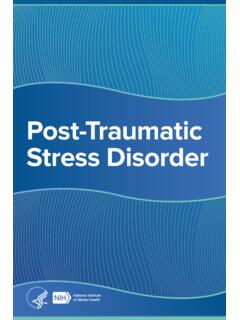Transcription of NONOPIOID TREATMENTS FOR CHRONIC PAIN
1 NONOPIOID TREATMENTS FOR CHRONIC PAINPRINCIPLES OF CHRONIC pain TREATMENTP atients with pain should receive treatment that provides the greatest benefit. Opioids are not the first-line therapy for CHRONIC pain outside of active cancer treatment , palliative care, and end-of-life care. Evidence suggests that NONOPIOID TREATMENTS , including NONOPIOID medications and nonpharmacological therapies can provide relief to those suffering from CHRONIC pain , and are safer. effective approaches to CHRONIC pain should: Use NONOPIOID therapies to the extent possible Identify and address co-existing mental health conditions ( , depression, anxiety, ptsd ) Focus on functional goals and improvement, engaging patients actively in their pain management Use disease-specific TREATMENTS when available ( , triptans for migraines, gabapentin/pregabalin/duloxetine for neuropathic pain ) Use first-line medication options preferentially Consider interventional therapies ( , corticosteroid injections)
2 In patients who fail standard non-invasive therapies Use multimodal approaches, including interdisciplinary rehabilitation for patients who have failed standard TREATMENTS , have severe functional deficits, or psychosocial risk factorsNONOPIOID MEDICATIONSMEDICATIONMAGNITUDE OFBENEFITSHARMSCOMMENTSA cetaminophenSmallHepatotoxic, particularly at higher dosesFirst-line analgesic, probably less effective than NSAIDsNSAIDsSmall-moderateCardiac, GI, renalFirst-line analgesic, COX-2 selective NSAIDs less GI toxicityGabapentin/pregabalinSmall-moder ateSedation, dizziness, ataxiaFirst-line agent for neuropathic pain ; pregabalin approved for fibromyalgiaTricyclic antidepressants and serotonin/norephinephrine reuptake inhibitorsSmall-moderateTCAs have anticholinergic and cardiac toxicities; SNRIs safer and better toleratedFirst-line for neuropathic pain ; TCAs and SNRIs for fibromyalgia, TCAs for headachesTopical agents (lidocaine, capsaicin, NSAIDs)Small-moderateCapsaicin initial flare/burning, irritation of mucus membranesConsider as alternative first-line, thought to be safer than systemic medications.
3 Lidocaine for neuropathic pain , topical NSAIDs for localized osteoarthritis, topical capsaicin for musculoskeletal and neuropathic painLEARN MORE | TREATMENTS FOR COMMON CHRONIC pain CONDITIONS Low back painSelf-care and education in all patients: advise patients to remain active and limit bedrestNonpharmacological TREATMENTS : Exercise, cognitive behavioral therapy, interdisciplinary rehabilitation Medications First-line: acetaminophen, non-steroidal anti-inflammatory drugs (NSAIDs) Second-line: Serotonin and norepinephrine reuptake inhibitors (SNRIs)/tricyclic antidepressants (TCAs)MigrainePreventive TREATMENTS Beta-blockers TCAs Antiseizure medications Calcium channel blockers Nonpharmacological TREATMENTS (Cognitive behavioral therapy, relaxation, biofeedback, exercise therapy) Avoid migraine triggers Acute TREATMENTS Aspirin, acetaminophen, NSAIDs (may be combined with caffeine) Antinausea medication Triptans-migraine-specific Neuropathic painMedications: TCAs, SNRIs, gabapentin/pregabalin, topical lidocaine OsteoarthritisNonpharmacological TREATMENTS : Exercise, weight loss, patient education Medications First-line: Acetaminophen, oral NSAIDs, topical NSAIDs Second-line: Intra-articular hyaluronic acid, capsaicin (limited number of intra-articular glucocorticoid injections if acetaminophen and NSAIDs insufficient)FibromyalgiaPatient education.
4 Address diagnosis, treatment , and the patient s role in treatmentNonpharmacological TREATMENTS : Low-impact aerobic exercise ( , brisk walking, swimming, water aerobics, or bicycling), cognitive behavioral therapy, biofeedback, interdisciplinary rehabilitation Medications FDA-approved: Pregabalin, duloxetine, milnacipran Other options: TCAs, gabapentinLEARN MORE |












